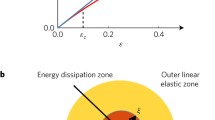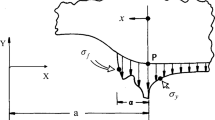Abstract
The stress distribution at the tip of a crack can be expanded as a power series. The first term, usually called the stress intensity factor, determines the initiation of fracture in a brittle material. In this paper it is shown that the second, third and fourth terms have the following effects:
-
(a)
the second term controls the stability of the crack's direction,
-
(b)
the third term controls the stability of the crack's propagation,
-
(c)
the fourth term determines whether the maximum shear stress on the prolongation of the crack increases or decreases with distance from the crack tip.
Résumé
Le champ des containtes de tension à l'éxtrémité d' une fissure peut être dévelopé en séries. Le premier terme, qu'on appelle ordinairement le facteur d' intensité de tension, determine l' amorçage de la fracture dans un matériel fragile. Dans cet article on montre que le deuxième, troisièrne et quatrième termes ont les effets suivants:
-
a)
le second terme controle la stabilité de la direction de la fissure.
-
b)
le troisième terme controle la stabilité de la propagation de la fissure.
-
c)
le quatrième terme determine si la valeur maximale de la contrainte de cisaillement sur la prolongation de la fissure augmente ou diminue par rapport a la distance avec l'éxtrémité de la fissure.
Zusammenfassung
Das Spannungsfeld einer Riss-spitze kann als eine Potenzreihe geschrieben werden. Das erste Glied ist gewöhnlich als Spannungsintensitätsfaktor bekant and bestimmt die Bildung des Bruchs in spröden Materialen. Dieser Beitrag zeigt das die nächsten drei Glieder die folgenden Wirkungen haben:
-
a)
Das zweite Glied befehlt die Stabilität der Richtung des Risses,
-
b)
Das dritte Glied befehlt die Stabilität der Fortpflanzung des Risses,
-
c)
Das vierte Glied entscheidet ob die maximale Schubkraft auf der Verbängerung des Risses mit Abstand von der Riss-spitze sich vermindert oder verstärkt.
Similar content being viewed by others
References
B. Cotterell Intl. J. Frac. Mech., 1, 96 (1965).
F. Erdogan and G. C. Sih Trans. ASME, J. Basic Engr., 85, D, 519 (1963).
M. L. Williams Trans. ASME, J. Appl. Mech., 24, 111 (1957).
N. I. Muskhelishvili Some Basic Problems of the Mathematical Theory of Elasticity, Noordhoff, Groningen (1953).
J. P. Berry J. Appl. Phys., 34, 62 (1963).
J. J. Benbow and F. C. Roesler Proc. Phys. Soc., 70, 201 (1957).
R. Guemsey and J. GilmanExp. Mech., 1, 50 (1961).
A. M. Sullivan Trans. ASME, J. Basic Engr., 87, D, 298 (1965).
M. J. Manjoine Trans. ASME, J. Basic Engr., 87, D, 293 (1965).
Author information
Authors and Affiliations
Rights and permissions
About this article
Cite this article
Cotterell, B. Notes on the paths and stability of cracks. Int J Fract 2, 526–533 (1966). https://doi.org/10.1007/BF00193691
Received:
Issue Date:
DOI: https://doi.org/10.1007/BF00193691




